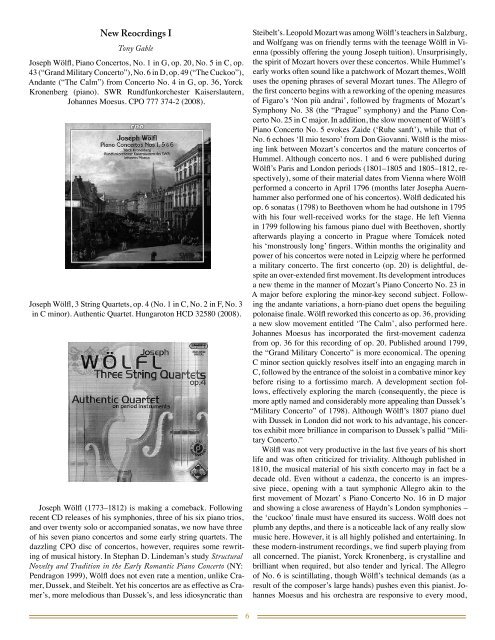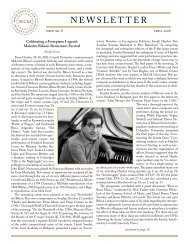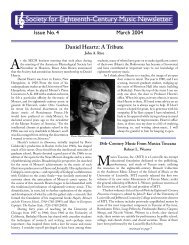NEWSLETTER - Society for 18th-Century Music
NEWSLETTER - Society for 18th-Century Music
NEWSLETTER - Society for 18th-Century Music
You also want an ePaper? Increase the reach of your titles
YUMPU automatically turns print PDFs into web optimized ePapers that Google loves.
New Reocrdings I<br />
Tony Gable<br />
Joseph Wölfl, Piano Concertos, No. 1 in G, op. 20, No. 5 in C, op.<br />
43 (“Grand Military Concerto”), No. 6 in D, op. 49 (“The Cuckoo”),<br />
Andante (“The Calm”) from Concerto No. 4 in G, op. 36, Yorck<br />
Kronenberg (piano). SWR Rundfunkorchester Kaiserslautern,<br />
Johannes Moesus. CPO 777 374-2 (2008).<br />
Joseph Wölfl, 3 String Quartets, op. 4 (No. 1 in C, No. 2 in F, No. 3<br />
in C minor). Authentic Quartet. Hungaroton HCD 32580 (2008).<br />
Joseph Wölfl (1773–1812) is making a comeback. Following<br />
recent CD releases of his symphonies, three of his six piano trios,<br />
and over twenty solo or accompanied sonatas, we now have three<br />
of his seven piano concertos and some early string quartets. The<br />
dazzling CPO disc of concertos, however, requires some rewriting<br />
of musical history. In Stephan D. Lindeman’s study Structural<br />
Novelty and Tradition in the Early Romantic Piano Concerto (NY:<br />
Pendragon 1999), Wölfl does not even rate a mention, unlike Cramer,<br />
Dussek, and Steibelt. Yet his concertos are as effective as Cramer’s,<br />
more melodious than Dussek’s, and less idiosyncratic than<br />
6<br />
Steibelt’s. Leopold Mozart was among Wölfl’s teachers in Salzburg,<br />
and Wolfgang was on friendly terms with the teenage Wölfl in Vienna<br />
(possibly offering the young Joseph tuition). Unsurprisingly,<br />
the spirit of Mozart hovers over these concertos. While Hummel’s<br />
early works often sound like a patchwork of Mozart themes, Wölfl<br />
uses the opening phrases of several Mozart tunes. The Allegro of<br />
the first concerto begins with a reworking of the opening measures<br />
of Figaro’s ‘Non più andrai’, followed by fragments of Mozart’s<br />
Symphony No. 38 (the “Prague” symphony) and the Piano Concerto<br />
No. 25 in C major. In addition, the slow movement of Wölfl’s<br />
Piano Concerto No. 5 evokes Zaide (‘Ruhe sanft’), while that of<br />
No. 6 echoes ‘Il mio tesoro’ from Don Giovanni. Wölfl is the missing<br />
link between Mozart’s concertos and the mature concertos of<br />
Hummel. Although concerto nos. 1 and 6 were published during<br />
Wölfl’s Paris and London periods (1801–1805 and 1805–1812, respectively),<br />
some of their material dates from Vienna where Wölfl<br />
per<strong>for</strong>med a concerto in April 1796 (months later Josepha Auernhammer<br />
also per<strong>for</strong>med one of his concertos). Wölfl dedicated his<br />
op. 6 sonatas (1798) to Beethoven whom he had outshone in 1795<br />
with his four well-received works <strong>for</strong> the stage. He left Vienna<br />
in 1799 following his famous piano duel with Beethoven, shortly<br />
afterwards playing a concerto in Prague where Tomácek noted<br />
his ‘monstrously long’ fingers. Within months the originality and<br />
power of his concertos were noted in Leipzig where he per<strong>for</strong>med<br />
a military concerto. The first concerto (op. 20) is delightful, despite<br />
an over-extended first movement. Its development introduces<br />
a new theme in the manner of Mozart’s Piano Concerto No. 23 in<br />
A major be<strong>for</strong>e exploring the minor-key second subject. Following<br />
the andante variations, a horn-piano duet opens the beguiling<br />
polonaise finale. Wölfl reworked this concerto as op. 36, providing<br />
a new slow movement entitled ‘The Calm’, also per<strong>for</strong>med here.<br />
Johannes Moesus has incorporated the first-movement cadenza<br />
from op. 36 <strong>for</strong> this recording of op. 20. Published around 1799,<br />
the “Grand Military Concerto” is more economical. The opening<br />
C minor section quickly resolves itself into an engaging march in<br />
C, followed by the entrance of the soloist in a combative minor key<br />
be<strong>for</strong>e rising to a <strong>for</strong>tissimo march. A development section follows,<br />
effectively exploring the march (consequently, the piece is<br />
more aptly named and considerably more appealing than Dussek’s<br />
“Military Concerto” of 1798). Although Wölfl’s 1807 piano duel<br />
with Dussek in London did not work to his advantage, his concertos<br />
exhibit more brilliance in comparison to Dussek’s pallid “Military<br />
Concerto.”<br />
Wölfl was not very productive in the last five years of his short<br />
life and was often criticized <strong>for</strong> triviality. Although published in<br />
1810, the musical material of his sixth concerto may in fact be a<br />
decade old. Even without a cadenza, the concerto is an impressive<br />
piece, opening with a taut symphonic Allegro akin to the<br />
first movement of Mozart’ s Piano Concerto No. 16 in D major<br />
and showing a close awareness of Haydn’s London symphonies –<br />
the ‘cuckoo’ finale must have ensured its success. Wölfl does not<br />
plumb any depths, and there is a noticeable lack of any really slow<br />
music here. However, it is all highly polished and entertaining. In<br />
these modern-instrument recordings, we find superb playing from<br />
all concerned. The pianist, Yorck Kronenberg, is crystalline and<br />
brilliant when required, but also tender and lyrical. The Allegro<br />
of No. 6 is scintillating, though Wölfl’s technical demands (as a<br />
result of the composer’s large hands) pushes even this pianist. Johannes<br />
Moesus and his orchestra are responsive to every mood,





